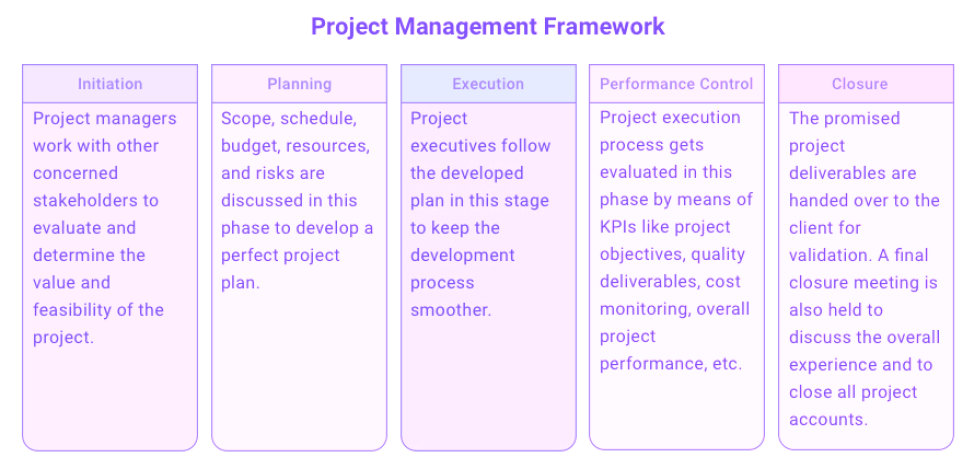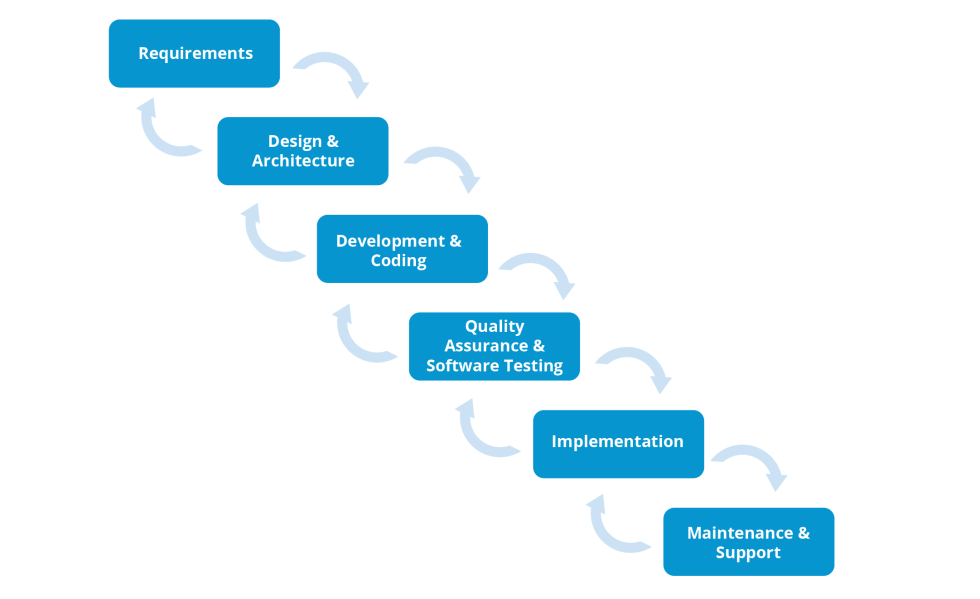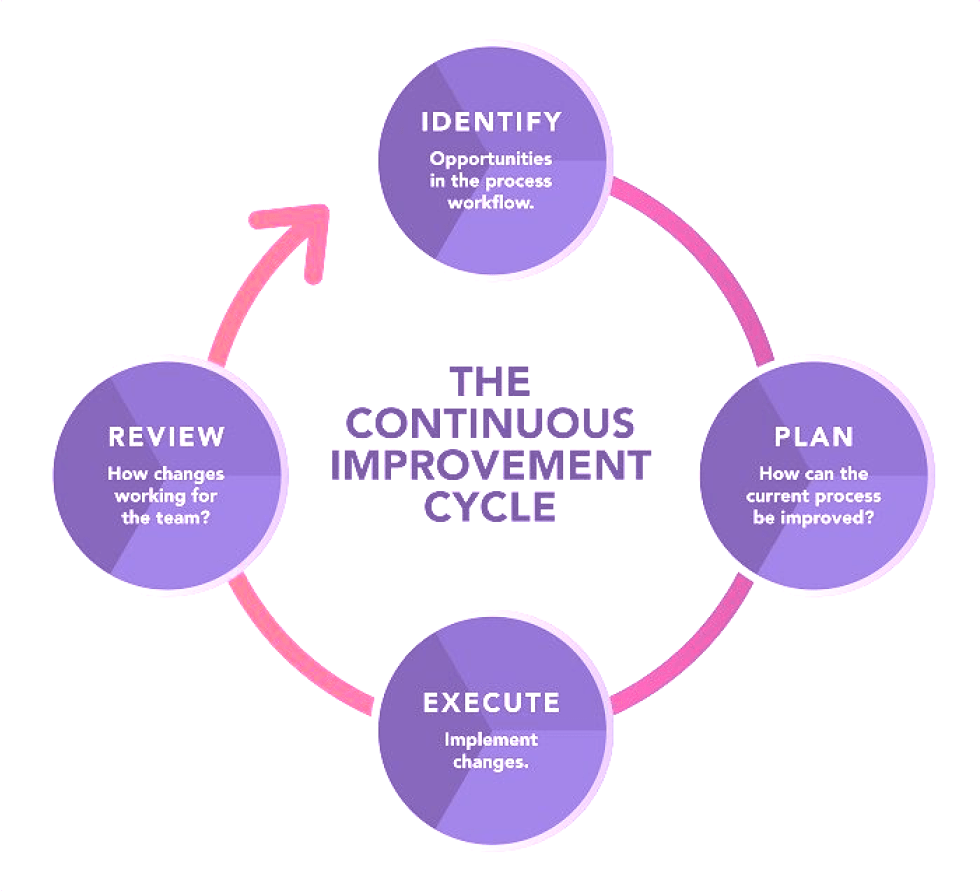Project Management Guide
Project Management Guide
What Is Project Management?
What Is a Project?
Why Is Project Management Important?
Project Life Cycle Phases
- Project Initiation
- Project Planning
- Project Execution
- Project Monitoring
- Project Closure
Project Management Methodologies
- Waterfall Project Management
- Critical Path Method
- Critical Chain Project Management
- Agile Project Management
- Scrum Project Management
- Kanban Project Management
- Lean Project Management
- Six Sigma Project Management
- PRINCE2
- PRiSM
- PMBOK Method
Project Management FAQ
What Is a Project Management Framework?
Project Management Frameworks, and How They Can Ensure Success
There’s one thing that all seasoned project managers know. And that is: no project is carried out under ideal circumstances.
According to a Standish Group white paper, a staggering 31.1% of projects will be canceled before they ever get completed. And 52.7% of projects will cost 189% of their original estimates.
One of the most important tools that the project manager has to prevent this is to take into account all current circumstances, and then plan resources and timelines extremely carefully. Such scanning and allocation should be done first and foremost, well before the project begins.
This is where a project management framework comes in. Simply put, it’s a way of structuring a project’s tasks by providing a set of processes, tasks, and tools.
In this way, it’s a plan and a guide that is of invaluable help to the project manager and team members on how to go about successfully completing the project.
As such, choosing and implementing the right project management framework is a critical step. It facilitates decision-making, communication, and coordination across teams and stakeholders.
According to a Project Management Institute’s survey, teams that come up with a well-thought-out project plan have a project success rate of 71% compared to an industry standard of 64%.
Here, we’re going to discuss:
- What a project management framework consists of
- What are its benefits
- Some framework models
By the end, you should have a good working knowledge of how to go about selecting and then preparing one so that your project is blessed with success.
What Does a Project Management Framework Consist of?

Most project management frameworks have three general components:
1. the project lifecycle, 2. the project control cycle, and 3. tools and templates.
These should work in combination with one another to make the project move ahead in a seamless fashion.
The Project Lifecycle
The project lifecycle is basically all that a project involves, from starting gun to finishing line. It’s essential to get a broad view of this in order to organize a project management framework.
Project lifecycles can be broken down further into five components. Initiation, planning, execution, management, and review.
Initiation is the starting phase. Here, research and planning are needed to do with the specific nature of the project. Also important is taking inputs from stakeholders about their concerns and expectations. Team members and external partners need to be spoken to, and discussions conducted on inputs and other best practices.
Planning is the next step. The project tasks and deliverables, along with timelines, should be identified. Resources have to be allocated and priorities assigned. Specific teams need to be made aware of their responsibilities, along with the milestones on the way to project completion.
Execution is the starting point of the project. The personnel involved get their brief and start work. They begin to employ resources and time to move towards the completion of their specific deliverables.
Management is the component of monitoring, reviewing, updating, and reporting. Assessments of progress need to be carried out, with appropriate course corrections, if any. Key stakeholders have to be kept in the loop about this. Recording relevant information is also an important part of this stage.
Review comes after the project has been successfully completed. At this point, stakeholders, clients, and team members have to be notified of successes and what could have been improved upon. This is also important as a guide for future projects.
As should be clear from the above, the project lifecycle is a critical part of the project management framework. Each phase needs to be recognized and mapped, connections made, and as well as setting up a communications model between key personnel.
The Project Control Cycle
The project control cycle is that part of the framework in which monitoring and management parameters are established.
Typically, this step will involve the technology such as software that is needed to successfully achieve this. Also important is the laying down of benchmarks in terms of success metrics. These are important in the evaluation as well as in reporting to senior stakeholders about the project progress.
The control cycle will vary depending on whether the project is simple or complex. Especially when the project is spread across various geographies, it’s critical for control and reporting systems to be robust.
In many projects, especially those involving software development and implementation, such a control cycle will have to take into account methods of testing and research, as well as the rework involved.
Tools and Templates
In this component, the project plan will have to make clear the various templates, analytic tools, workflow models, and other methods of measurement and analysis.
Obviously, the more standardized such tools and templates are across phases and teams, the more seamless the process is. For this, it’s also important for everyone concerned to have prior knowledge and, if possible, the experience of such working methods.
This is a vital step when it comes to successful scheduling, delegation, collaboration, documentation, and evaluation. It keeps everyone on the same page, with the same methods and routines of productivity and assessment.
What are the Benefits of a Project Management Framework?
Without a proper project management framework in place, there are good chances of the project spreading out in all directions without central control and without members being aware of what they need to achieve.
Thus, the major advantages of a common project management framework are:
- Skills can be streamlined and enhanced as well as harnessed towards common goals.
- All the departments involved can be better integrated, such as finance, HRD, and IT.
- An established framework can create an asset in the form of consistent processes that can be repeatedly employed in the long term.
- It increases the chances of project completion on time, within budget, and to the parameters assigned.
A consistent set of processes and tools can also help in comparing various projects. This can facilitate prioritization as well as allocating resources.
With common tools and templates, training and skillsets are also easier to identify and enhance.
Thus, a project management framework means stronger project management skills and practices. For a project manager, it is an essential tool to create a successful outcome.
Some Project Management Framework Models
We don’t have to spell out that projects come in various shapes, sizes, and degrees of complexity. As such, there is no one project management framework model that will fit comfortably across projects.
Over the years, there are a few models that have been widely and successfully used.
Waterfall method
This is an approach in which the project is completed in distinct and separate stages. It moves in a linear, step-by-step fashion. One overall plan is made, and sequential steps are taken towards completion. The next phase starts only when the previous one ends. It’s clear, easy to understand, and measure but doesn’t work as well with complex projects with overlapping requirements that can be subject to changes

Critical Chain Project Management
This approach is focused on allocating resources appropriately across the entire project. It does this by identifying the critical areas. It also highlights specific steps where resources and criticality are less important. Buffers are built in to ensure that timelines are adhered to. This method is suitable for large, resource-hungry projects as well as projects where resources are scarce and have to be used efficiently.
Agile Methodology
This is commonly used for software projects. It builds in concurrent development and testing at all stages. Individual and team actions and discussions are prioritized. Collaborations are important, as well as space and resources for continuous iterations.
Extreme Project Management
Also known as XPM, this is a flexible approach that incorporates changing needs. Typically this is suited to short-term projects. In such cases, there are many variables that could lead to several modifications as the project proceeds. Revisions and changing expectations thus become part of the process.
The Scrum Method
This is appropriate for projects that involve small teams that have to work together consistently to reach project outcomes. The overall project deliverables here are broken up into smaller tasks that can be distributed across teams that can complete them with minimum wastage.
The Lean Method
As the name implies, this depends on people working together to minimize waste, whether of resources or of time. It’s for projects that have reduced lead times and costs while needing quality and efficiency. The mapping of value as well as improving efficiency along the entire project cycle are important considerations with this approach.

Prince2 Approach
This stands for Projects in Controlled Environments and is one of the most widely used nowadays. Here, processes are prioritized, with a high degree of organization and control from start to finish. Such projects are highly structured, with clearly defined expectations, roles, and outputs.
To sum up, project management frameworks are vital in getting an overview of any project and then overseeing it to completion. There are various types of models, and the right one depends on the nature of the project.
Choose carefully, fill out your framework with resources and expectations, and you can be one of the most successful project managers around.
